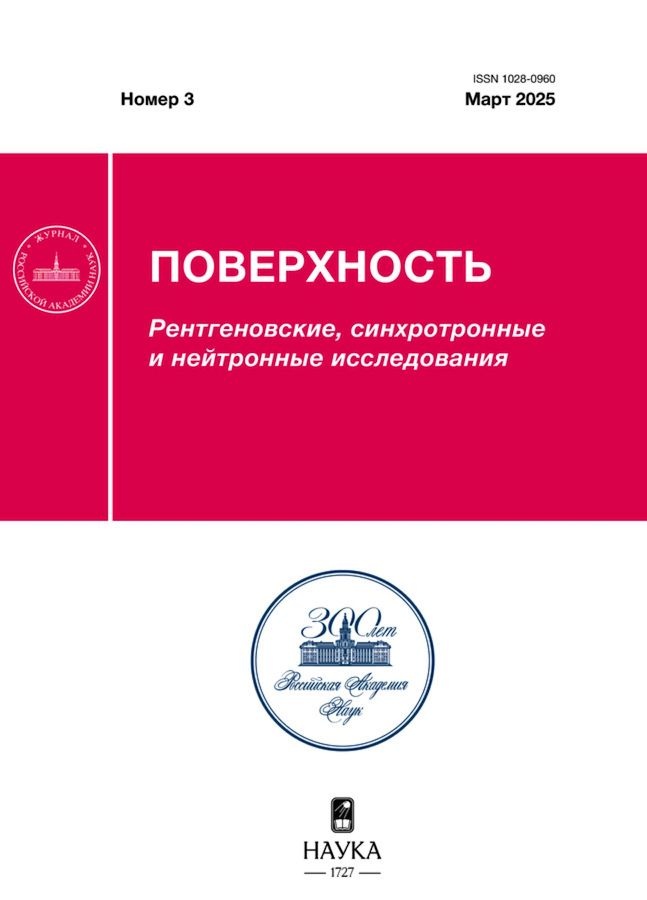Energy spectra of atoms sputtered by low-energy ions: computer simulation
- Авторлар: Shulga V.I.1
-
Мекемелер:
- D.V. Skobeltsin Institute of Nuclear Physics, Lomonosov Moscow State University
- Шығарылым: № 3 (2025)
- Беттер: 69-74
- Бөлім: Articles
- URL: https://rjsocmed.com/1028-0960/article/view/687681
- DOI: https://doi.org/10.31857/S1028096025030111
- EDN: https://elibrary.ru/EMFPTF
- ID: 687681
Дәйексөз келтіру
Аннотация
The energy spectra and average energies of sputtered atoms were calculated for a number of amorphous targets (Si, Ti, Ni, V and Nb) bombarded with 1 keV Ar ions. The calculations were carried out using the computer simulation programs OKSANA and SRIM-2013. It is shown that for targets whose atoms are heavier than incident ions, SRIM can greatly overestimate the contribution of fast sputtered atoms. This is especially noticeable in calculations with the surface binding energy found by adjusting the calculated sputtering yields to the experimental ones. The simulation results are compared with analytical estimates of the average energy of ejected atoms based on the linear theory of sputtering. It is shown that in all the cases considered, these estimates are also greatly overestimated, since they do not take into account the degradation of collision cascades at low bombarding energies. A good agreement of the OKSANA, TRIM.SP and ACAT simulations is noted.
Толық мәтін
Авторлар туралы
V. Shulga
D.V. Skobeltsin Institute of Nuclear Physics, Lomonosov Moscow State University
Хат алмасуға жауапты Автор.
Email: vish008@yandex.ru
Ресей, Moscow
Әдебиет тізімі
- Распыление под действием бомбардировки частицами. III. Характеристики распыленных частиц, применения в технике. / Ред. Бериш Р., Виттмак. К. М.: Мир. 1998. 551 с.
- Sputtering by Particle Bombardment. Experiments and Computer Calculations from Threshold to MeV Energies. / Ed. Behrisch R., Eckstein W. Springer, Berlin, 2007. 459 р.
- Ziegler J.F., Ziegler M.D., Biersack J.P. // Nucl. Instrum. Methods Phys. Res. B. 2010. V. 268. P. 1818. https://www.doi.org/10.1016/j.nimb.2010.02.091.
- Hofsäss H., Zhang K., Mutzke A. // Appl. Surf. Sci. 2014. V. 310. P. 134. https://www.doi.org/10.1016/j.apsusc.2014.03.152
- Shulga V.I. // Appl. Surf. Sci. 2018. V. 439. P. 456. https://www.doi.org/10.1016/j.apsusc.2018.01.039
- Mahne N., Čekada M., Panjan M. // Coatings. 2022. V. 12. P. 1541. https://www.doi.org/10.3390/coatings12101541
- Mahne N., Čekada M., Panjan M. // Coatings. 2023. V. 13. P. 1448. https://www.doi.org/10.3390/coatings13081448
- Экштайн В. Компьютерное моделирование взаимодействия частиц с поверхностью твердого тела. М.: Мир. 1995. 319 с.
- Shulga V.I., Eckstein W. // Nucl. Instrum. Methods Phys. Res. B. 1998. V. 145. P. 492. https://www.doi.org/10.1016/S0168-583X(98)00626-0
- Ziegler J.F., Biersack J.P., Littmark U. The Stopping and Range of Ions in Solids, Vol. I. Pergamon, New York, 1985.
- Oen O.S., Robinson M.T. // Nucl. Instrum. Methods. 1976. V. 132. P. 647. https://www.doi.org/10.1016/0029-554X(76)90806-5
- Lindhard J., Scharff M. // Phys. Rev. 1961. V. 124. P. 128. https://www.doi.org/10.1103/PhysRev.194.128
- Шульга В.И. // ЖТФ. 2023. Т. 93. С. 1401. https://www.doi.org/10.21883/JTF.2023.10.56276.147-23
- Sigmund P. Sputtering by ion bombardment: theoretical concepts. // Sputtering by Particle Bombardment I. Physical Sputtering of Single-Element Solids. / Ed. Behrisch R. Springer, Berlin. 1981. P. 9.
- Thompson M.W. // Philos. Mag. 1968. V. 18. P. 377. https://www.doi.org/10.1080/14786436808227358
- Held J., Hecimovic A., von Keudell A., Schulz-von der Gathen V. // Plasma Sources Sci. Technol. 2018. V. 27. P. 105012. https://www.doi.org/10.1088/1361-6595/aae236
- Eckstein W. // Nucl. Instrum. Methods Phys. Res. B. 1986. V. 18. P. 344. https://www.doi.org/10.1016/S0168-583X(86)80056-8
- Dembowski J., Oechsner H., Yamamura Y., Urbassek M. // Nucl. Instrum. Methods Phys. Res. B. 1986. V. 18. P. 464. https://www.doi.org/10.1016/S0168-583X(86)80072-6
- Lindsey S., Hobler G. // Nucl. Instrum. Methods Phys. Res. B. 2013. V. 303. P. 142. https://www.doi.org/10.1016/j.nimb.2012.12.087
- Brizzolara R.A., Cooper C.B., Olson T.K. // Nucl. Instrum. Methods Phys. Res. B. 1988. V. 35. P. 36. https://www.doi.org/10.1016/0168-583X(88)90095-x
- Mousel T., Eckstein W., Gnaser H. // Nucl. Instrum. Methods Phys. Res. B. 1999. V. 152. P. 36. https://www.doi.org/10.1016/s0168-583X(98)00976-8
- Shulga V.I. // Vacuum. 2024. V. 230. P. 113644. https//www.doi.org/10.1016/j.vacuum.2024.113644
Қосымша файлдар













